53 found, showing page 2 of 4
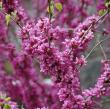
The 'Don Egolf' is admired for its purplish-pink blooms that appear in the early spring. It has an upright growth habit and will reach 10-12' tall and wide at maturity. Great for smaller garden spaces.
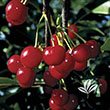
The 'Juliet' is a dwarf, shrub-like variety that produces a large crop of deep-red cherries that have a deliciously sweet, yet richly complex, flavor. Its super sweet, yet mildly tart flavor makes these cherries perfect for baking, jams, ice cream fresh eating, and even freezing for later use. They will grow 5-8' tall and wide and fruit will ripen in mid-summer.
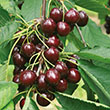
The 'Regina' produces fruit that is sweet-tart when picked red and incredibly sweet when left to ripen and turn deep purple. Fruit has a distinctive cherry flavor and will ripen in late-June. This variety needs to be planted with other sweet-cherry varieties, like 'Celeste' and 'Stardust'. Will average 8-10' tall and wide.
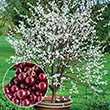
The 'Romeo' explodes with showy, white, fragrant flowers in the spring, and is later covered in dark, purple-red berries in the summer. These berries have a high sugar level, creating the perfect sweet-tart cherry flavor, great for cooking, canning, jellies and jams. Grows 6-8' tall and 4-6' wide.
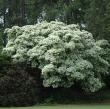
The Chinese fringe tree is a stunning specimen for both small and large yard spaces. It grows 15-20' tall and 20-25' wide, offering lots of shade for outdoor seating spaces. In late spring, the tree will be covered in white, elongated flowers that contrast against dark green foliage and have been known to glow in the moonlight.
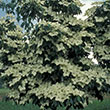
The 'Greensleeves' dogwood is a quick grower with heavy flower production. Large, creamy-white blossoms tinged with green appear in early summer and persist through the season. It will reach 20-30' tall and wide at full maturity. Green foliage turns shades of autumn and purple in the fall.

The 'Scarlet Fire' offers beautiful colors all year long. Dark green leaves emerge with purple-tinged new growth, then turn bright red in the fall. Its most striking feature is its bright fuschia flowers that last 6-8 weeks from the May through June. It will get 20-25' tall and 15-20' wide at full maturity.

Venus' has a broad, rounded growth habit, reaching 15-20' tall and wide at maturity. It produces massive clusters of large, true-white flowers in late spring that persist into summer.
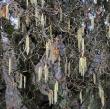
The Harry Lauder's Walking Stick is prized for its winter appearance, with thick, contorting branches and drooping, yellow catkins that appear on the stems in late winter. They have broadly, ovate green leaves from spring through fall. Will grow 8-10' tall and wide.
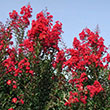
This reblooming variety provides an explosion of color all summer long. The 'Double Dynamite' produces intense, cherry-red blossoms that appear in early summer and will persist throughout the season. Dark purple foliage emerges and ages to dark green.
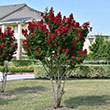
The 'Dynamite' provides vibrant, colorful interest all year long. It produces huge clusters of vibrant, red blooms that persist through the summer and contrast against its rich, green foliage. Colorful, peeling bark in the winter and orange-red fall foliage add seasonal interest. This large variety will quickly reach 20-25' tall and 15-20' wide.

Height: 15 feet
Spread: 15 feet
Sunlight: full sun partial shade
Hardiness Zone: 6a
Other Names: Crape Myrtle, Crepe Myrtle
Description:
This exceptionally cold hardy, semi-dwarf variety is covered in frilly pink blooms in summer, followed by deep red fall foliage; a captivating focal point for the garden or border
Ornamental Features:
Hopi Crapemyrtle is clothed in stunning panicles of pink frilly flowers at the ends of the branches from early to late summer. It has attractive dark green deciduous foliage which emerges coppery-bronze in spring. The oval leaves are highly ornamental and turn dark red in fall.
Landscape Attributes:
Hopi Crapemyrtle is a dense multi-stemmed deciduous shrub with a more or less rounded form. Its relatively fine texture sets it apart from other landscape plants with less refined foliage.
This is a relatively low maintenance shrub, and is best pruned in late winter once the threat of extreme cold has passed. It has no significant negative characteristics.
Hopi Crapemyrtle is recommended for the following landscape applications:
- Accent
- Mass Planting
- Hedges/Screening
- General Garden Use
- Container Planting
Planting & Growing:
Hopi Crapemyrtle will grow to be about 15 feet tall at maturity, with a spread of 15 feet. It has a low canopy with a typical clearance of 2 feet from the ground, and is suitable for planting under power lines. It grows at a fast rate, and under ideal conditions can be expected to live for 50 years or more.
This shrub does best in full sun to partial shade. It prefers to grow in average to moist conditions, and shouldn't be allowed to dry out. It is very fussy about its soil conditions and must have rich, acidic soils to ensure success, and is subject to chlorosis (yellowing) of the foliage in alkaline soils. It is highly tolerant of urban pollution and will even thrive in inner city environments. This particular variety is an interspecific
hybrid.
Hopi Crapemyrtle makes a fine choice for the outdoor landscape, but it is also well-suited for use in outdoor pots and containers. Because of its height, it is often used as a 'thriller' in the 'spiller-thriller-filler' container combination; plant it near the center of the pot, surrounded by smaller plants and those that spill over the edges. It is even sizeable enough that it can be grown alone in a suitable container. Note that when grown in a container, it may not perform exactly as indicated on the tag - this is to be expected. Also note that when growing plants in outdoor containers and baskets, they may require more frequent waterings than they would in the yard or garden.
53 found, showing page 2 of 4